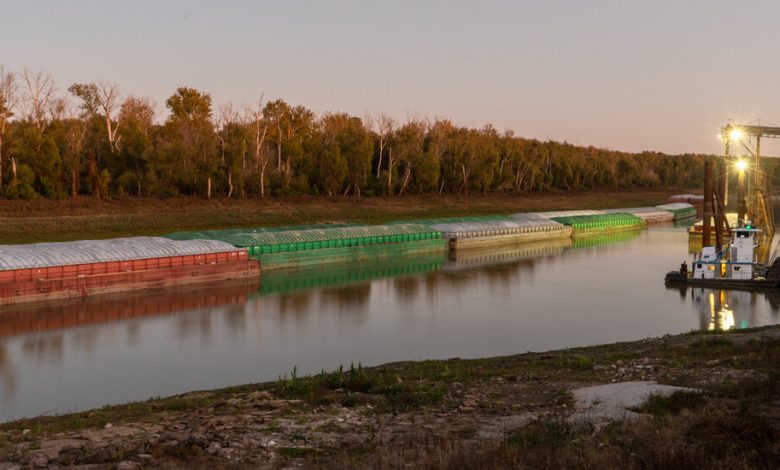Long Stretches of the Mississippi River Have Run Dry. What’s Next?

Last month, record low water levels in the Mississippi River backed up nearly 3,000 barges — the equivalent of 210,000 container trucks — on America’s most important inland waterway. Despite frantic dredging, farmers could move only half the corn they’d shipped the same time last year. Deliveries of fuel, coal, industrial chemicals and building materials were similarly delayed throughout the nation’s heartland.
This critical river and its tributaries — responsible for transporting more than $17 billion worth of farm products and 60 percent of all U.S. corn and soybean exports annually — has been stricken by drought since September, amid a time of global grain shortage and soaring food prices. While water levels will recover modestly this week, thanks to some upstream rain and snow, the long-term forecast remains dry.
Conditions are even worse in the southwestern United States, where an ongoing 22-year drought — now the harshest in 1,200 years — has shriveled Colorado River reservoirs, straining water supplies for farms, cities and hydropower from the Hoover Dam. Across the Atlantic in Germany, warmer temperatures and longer droughts have shrunk the Rhine River, making navigation harrowing on a waterway responsible for up to 80 percent of the country’s ship-bound cargo.
Economic powerhouse rivers like these are being sucked dry not only by climate change but by fast-growing cities and farming operations that need more water. Agriculture is the single largest consumer of freshwater, and global food demand is still rising.
There are no new rivers left to tap. We must learn to do more with less.
Radical new thinking is the only way to make sure our rivers endure. The good news is that we are already reimagining what rivers can do — and what they can be.
Because rivers deposit sand, plugging shipping channels and reservoirs, their power to move sediment is normally framed as a problem to be fixed by dredging. But in Louisiana, where coastal wetlands are disappearing rapidly, a roughly $2.2 billion proposal is advancing to divert part of the Mississippi River into Barataria Bay, where additional sediment can help protect it from rising sea levels. Using BP settlement money from the 2010 Deepwater Horizon oil spill catastrophe, the Mid-Barataria Sediment Diversion would mimic natural delta-building processes in a place that has lost hundreds of square miles of coastal land over the last century. Projects like this one make the Mississippi’s ability to move sediment an asset rather than an expense.
If reservoirs fall to the point where they can barely be used for hydropower, they can still be used to store intermittent wind and solar energy — by recycling water that has already passed through the dam’s turbines back into its reservoir.
One outlandish proposal to do this at a massive scale reimagines the Hoover Dam as a three-billion-dollar renewable energy battery, connecting it to vast new solar and wind farms. While logistical issues make this particular idea a moonshot, there are plenty of opportunities to connect dams with renewable energy farms at a much smaller scale and lower cost.
Creative opportunities also exist for small, low-impact hydropower technologies — including modernized water wheels that can be retrofitted into existing or historical dam structures. Some technologies require no existing structures at all. Hydropower projects that are small enough to operate in reduced flows and small rivers can generate clean, renewable electricity with little environmental downside. Already some 200 low impact projects in the United States have been approved or are pending certifications, and across Europe there may be nearly 30,000 more potential sites at old mills.
Simply ripping out obsolete structures can have a big effect, too, restoring rivers to a free-flowing state with tremendous ecological and recreational benefits. Federal regulators have just approved an extraordinary plan to demolish four aging dams that for a century have been blocking salmon spawning runs on the Klamath River in California and Oregon, drawing protest from Native American tribes and fishermen. Rivers restore their old characteristics amazingly quickly once their shackles are removed. Based on studies of smaller dam demolitions on the Elwha River and others in the Pacific Northwest, salmon should begin recolonizing their ancestral waterway almost immediately.
Some bold ideas require no modification of rivers at all. New space-based technologies can track freshwater levels globally, helping to enforce international water-sharing agreements and strengthen river forecasting models. Laser measurements from NASA’s ICESat-2 satellite demonstrated the potential for this recently. Next month, the United States and France will launch the SWOT (Surface Water and Ocean Topography) satellite, a new radar technology that will blanket the Earth with three-dimensional measurements of water levels and river discharge. These data, if proven after testing, could help all nations manage their freshwater resources with observations both within and outside their borders.
Throughout history, societies have grown and prospered along rivers. Today, nearly two-thirds of us live alongside them. The ways in which societies use rivers have changed drastically over time, giving rise to cities, powering the Industrial Revolution and populating the world’s arid lands through massive dams and water diversion schemes, among other transitions. It’s time now to reimagine our relationship with rivers once again.
Laurence C. Smith is a professor of environmental studies and earth, environmental and planetary sciences at Brown University and the author of “Rivers of Power: How a Natural Force Raised Kingdoms, Destroyed Civilizations and Shapes Our World.”
The Times is committed to publishing a diversity of letters to the editor. We’d like to hear what you think about this or any of our articles. Here are some tips. And here’s our email: [email protected].
Follow The New York Times Opinion section on Facebook, Twitter (@NYTopinion) and Instagram.
